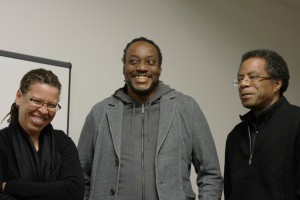 By Staff Writer: Sarah Rewers
By Staff Writer: Sarah Rewers
Last Wednesday, USF welcomed an unique presentation from the Three Point Nine Collective — an art group that strives to provide a community for all the African American artists living in the San Francisco Bay Area. The group was recently started in response to the recent decline of the African American population in San Francisco to a mere 3.9%, which is what inspired the collective’s title. As the population declined, so did the public attention to African American art. The purpose of the group is to shed public light on the African American artists living in the Bay Area and peg the question, “Does San Francisco care if African American people are here?”
As founder A.T. Stevens mentioned, the artists want to incorporate the “African American presence in the fabric of life” by exhibiting their art, and not letting the San Francisco media exclude them. The Three Point Nine Collective website further explains that “their work represents their creative contribution to the African American existence, enriching the greater San Francisco artistic community with their narratives and perspectives born from being members of a diaspora community.”
The four following artists presented impressive collections this past Wednesday evening: Ron Moultrie Saunders, Michael Ross, Sydney Cain, and Rodney Ewing. Saunders displayed his Secret Life of Plants collection, which included “photograms”—pictures formed without cameras—of plants and other organic materials. He is able to expand the size of little plants through his artwork, which he believes allows him to “not take nature for granted” and to “expose the plant form” that we otherwise might not take the time to recognize.
Ross, a San Francisco native, believes that art is the “blackest thing [he] can do” because it allows him to create his own conventions and express himself singularly.
He has lived in San Francisco for more than 20 years, and has observed the depressing decline not only in the city’s African American community, but also in the interest in African American art. He presented his collection of abstract houses that strikingly express intense human emotion through color and movement. Through his art, he aims to capture the “universality” of human emotion.
Cain is a student at California State University East Bay and spends her time creating mystical freestyle drawings and vibrant paintings of abstract patterns and shapes that form strange and intriguing figures. When asked how she wants to her art to affect society, she replied that she wants to “challenge the colonial cosmograms.”
By this, she means that she aims to provide a response to the shaping of the environment and presenting what art means to her. Through the original figures she creates, she is able to provide a “vessel for art” and depict the hidden side of herself as a young black woman.
Ewing creates beautiful paintings based on certain topical events, such as “Baptism” that was inspired by the tragic occurrences of the Port Chicago explosion that killed many African Americans during World War II.
He uses watercolor as a medium to represent the paradoxical effects of water in history, such as Hurricane Katrina. These paintings are presented in his collection titled “Rituals of Water.” Before he takes his brush to the paper, he first lets the watercolor form natural patterns and images overnight. Through Ewing’s historical images, he is able to “dissect memory to create a narrative” that sticks in one’s mind.
Thanks to the Three Point Nine Collective, these artists are receiving the deserved recognition that the San Franciscan media was not allotting them. If San Francisco represents tolerance and diversity, then it must continue to incorporate the strong presence of the African American community. By giving attention to these artists, we can maintain this essential community and not ignore the people who contribute culture and inspiration to this city.
